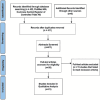Robotic-Assisted Versus Fluoroscopic-Guided Surgery on the Accuracy of Spine Pedicle Screw Placement: A Systematic Review and Meta-Analysis
- PMID: 38410625
- PMCID: PMC10896625
- DOI: 10.7759/cureus.54969
Robotic-Assisted Versus Fluoroscopic-Guided Surgery on the Accuracy of Spine Pedicle Screw Placement: A Systematic Review and Meta-Analysis
Abstract
Spinal fusion is a common method by which surgeons decrease instability and deformity of the spinal segment targeted. Pedicle screws are vital tools in fusion surgeries and advancements in technology have introduced several modalities of screw placement. Our objective was to evaluate the accuracy of pedicle screw placement in robot-assisted (RA) versus fluoroscopic-guided (FG) techniques. The PubMed and Cochrane Library databases were systematically reviewed from January 2007 through to August 8, 2022, to identify relevant studies. The accuracy of pedicle screw placement was determined using the Gertzbein-Robbins (GR) classification system. Facet joint violation (FJV), total case radiation dosage, total case radiation time, total operating room (OR) time, and total case blood loss were collected. Twenty-one articles fulfilled the inclusion criteria. Successful screw accuracy (GR Grade A or B) was found to be 1.02 (95% confidence interval: 1.01 - 1.04) times more likely with the RA technique. In defining accuracy solely based on the GR Grade A criteria, screws placed with RA were 1.10 (95% confidence interval: 1.06 - 1.15) times more likely to be accurate. There was no significant difference between the two techniques with respect to blood loss (Hedges' g: 1.16, 95% confidence interval: -0.75 to 3.06) or case radiation time (Hedges' g: -0.34, 95% CI: -1.22 to 0.53). FG techniques were associated with shorter operating room times (Hedges' g: -1.03, 95% confidence interval: -1.76 to -0.31), and higher case radiation dosage (Hedges' g: 1.61, 95% confidence interval: 1.11 to 2.10). This review suggests that RA may slightly increase pedicle screw accuracy and decrease per-case radiation dosage compared to FG techniques. However, total operating times for RA cases are greater than those for FG cases.
Keywords: accuracy; fluoroscopy; meta-analysis; pedicle screw; radiation; robotic; robotic assistance; spine surgery.
Copyright © 2024, Jung et al.
Conflict of interest statement
The authors have declared that no competing interests exist.
Figures



Similar articles
-
Comparison of robot-assisted versus fluoroscopy-guided transforaminal lumbar interbody fusion (TLIF) for lumbar degenerative diseases: a systematic review and meta-analysis of randomized controlled trails and cohort studies.Syst Rev. 2024 Jul 5;13(1):170. doi: 10.1186/s13643-024-02600-6. Syst Rev. 2024. PMID: 38970142 Free PMC article.
-
Comparison of Superior-Level Facet Joint Violations Between Robot-Assisted Percutaneous Pedicle Screw Placement and Conventional Open Fluoroscopic-Guided Pedicle Screw Placement.Orthop Surg. 2019 Oct;11(5):850-856. doi: 10.1111/os.12534. Orthop Surg. 2019. PMID: 31663290 Free PMC article.
-
Robotic versus fluoroscopy-guided pedicle screw insertion for metastatic spinal disease: a matched-cohort comparison.Neurosurg Focus. 2017 May;42(5):E13. doi: 10.3171/2017.3.FOCUS1710. Neurosurg Focus. 2017. PMID: 28463620
-
Positioning accuracy and facet joints violation after percutaneous pedicle screws placement with robot-assisted versus fluoroscopy-guided technique: Systematic review and meta-analysis.J Neurosci Rural Pract. 2023 Jul-Sep;14(3):406-412. doi: 10.25259/JNRP_147_2023. Epub 2023 Jul 27. J Neurosci Rural Pract. 2023. PMID: 37692811 Free PMC article. Review.
-
Robot-Assisted Versus Fluoroscopy-Guided Pedicle Screw Placement in Transforaminal Lumbar Interbody Fusion for Lumbar Degenerative Disease.World Neurosurg. 2019 May;125:e429-e434. doi: 10.1016/j.wneu.2019.01.097. Epub 2019 Jan 29. World Neurosurg. 2019. PMID: 30708077
Cited by
-
[Robotically assisted placement of a pubic ramus screw and an SI-S1 screw].Unfallchirurgie (Heidelb). 2025 Jul;128(7):560-564. doi: 10.1007/s00113-025-01580-z. Epub 2025 May 6. Unfallchirurgie (Heidelb). 2025. PMID: 40327092 Free PMC article. Review. German.
-
Robotic spine surgery compared with fluoroscopic-assisted surgery: advantages, disadvantages, future perspectives.J Robot Surg. 2025 Aug 10;19(1):474. doi: 10.1007/s11701-025-02654-1. J Robot Surg. 2025. PMID: 40783908
-
Does Robotic Spine Surgery Add Value to Surgical Practice over Navigation-Based Systems? A Study on Operating Room Efficiency.Medicina (Kaunas). 2024 Dec 23;60(12):2112. doi: 10.3390/medicina60122112. Medicina (Kaunas). 2024. PMID: 39768991 Free PMC article.
-
[Robotically assisted and minimally invasive pedicle screw placement at the lumbar spine].Unfallchirurgie (Heidelb). 2025 Aug;128(8):637-641. doi: 10.1007/s00113-025-01596-5. Epub 2025 Jun 26. Unfallchirurgie (Heidelb). 2025. PMID: 40569363 Free PMC article. German.
-
Hybrid-3D robotic suite in spine and trauma surgery - experiences in 210 patients.J Orthop Surg Res. 2024 Sep 14;19(1):565. doi: 10.1186/s13018-024-05044-9. J Orthop Surg Res. 2024. PMID: 39272126 Free PMC article.
References
-
- The history of vertebral screw and pedicle screw fixation. Kabins MB, Weinstein JN. https://www.ncbi.nlm.nih.gov/pmc/articles/PMC2328959/ Iowa Orthop J. 1991;11:127–136.
-
- Robotic spine surgery where did we come from, and where are we headed? Buza JA, Goldstein JA. https://go.gale.com/ps/i.do?id=GALE%7CA618321113&sid=googleScholar&v=2.1... Bull Hosp Jt Dis. 2016;78:17–25. - PubMed
-
- The Pransky interview: Professor Moshe Shoham, founder of Mazor Robotics and Microbot Medical. Pransky J. Ind Rob. 2014;41:393–397.
Publication types
LinkOut - more resources
Full Text Sources
